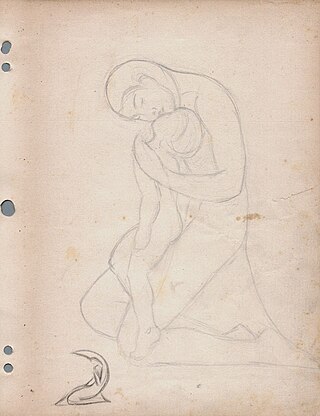Related Research Articles
A creator deity or creator god is a deity responsible for the creation of the Earth, world, and universe in human religion and mythology. In monotheism, the single God is often also the creator. A number of monolatristic traditions separate a secondary creator from a primary transcendent being, identified as a primary creator.
In Maya mythology, Cabaguil was a solar god who assisted in the creation of human beings.
In Hawaiian mythology, Kāne is considered the highest of the three major Hawaiian deities, along with Kū and Lono. He represented the god of procreation and was worshipped as ancestor of chiefs and commoners. Kāne is the creator and gives life associated with dawn, sun and sky. No human sacrifice or laborious ritual was needed in the worship of Kāne. In the Kumuhonua legend, he created Earth, bestowed upon it sea creatures, animals, plants, as well as created man and woman.

Chinese mythology is mythology that has been passed down in oral form or recorded in literature throughout the area now known as Greater China. Chinese mythology encompasses a diverse array of myths derived from regional and cultural traditions. Populated with engaging narratives featuring extraordinary individuals and beings endowed with magical powers, these stories often unfold in fantastical mythological realms or historical epochs. Similar to numerous other mythologies, Chinese mythology has historically been regarded, at least partially, as a factual record of the past.
Iranian mythology, or Persian mythology in western term, is the body of the myths originally told by ancient Persians and other Iranian peoples and a genre of ancient Persian folklore. These stories concern the origin and nature of the world, the lives and activities of deities, heroes, and mythological creatures, and the origins and significance of the ancient Persians' own cult and ritual practices. Modern scholars study the myths to shed light on the religious and political institutions of not only Iran but of the Persosphere, which includes regions of West Asia, Central Asia, South Asia, and Transcaucasia where the culture of Iran has had significant influence. Historically, these were regions long ruled by dynasties of various Iranian empires, that incorporated considerable aspects of Persian culture through extensive contact with them, or where sufficient Iranian peoples settled to still maintain communities who patronize their respective cultures. It roughly corresponds to the Iranian Plateau and its bordering plains.

Onyame, Nyankopon (Onyankapon) or Odomankoma is the supreme god of the Akan people of Ghana, who is most commonly known as Anyame. The name means "The one who knows and sees everything", and "omniscient, omnipotent sky deity" in the Akan language.
Georgian mythology refers to the mythology of pre-Christian Georgians, an indigenous Caucasian ethnic group native to Georgia and the South Caucasus. The mythology of the Kartvelian peoples is believed by many scholars to have formed part of the religions of the kingdoms of Diauehi, Colchis and Iberia.

Philippine mythology is rooted in the many indigenous Philippine folk religions. Philippine mythology exhibits influence from Hindu, Muslim, Buddhist, and Christian traditions.
Comparative mythology is the comparison of myths from different cultures in an attempt to identify shared themes and characteristics. Comparative mythology has served a variety of academic purposes. For example, scholars have used the relationships between different myths to trace the development of religions and cultures, to propose common origins for myths from different cultures, and to support various psychoanalytical theories.

The terms Muisca religion and mythology refer to the pre-Columbian beliefs of the Muisca indigenous people of the Cordillera Oriental highlands of the Andes in the vicinity of Bogotá, Colombia. The tradition includes a selection of received myths concerning the origin and organization of the universe. Their belief system may be described as a polytheistic religion containing a very strong element of spirituality based on an epistemology of mysticism.

Akan religion comprises the traditional beliefs and religious practices of the Akan people of Ghana and eastern Ivory Coast. Akan religion is referred to as Akom. Although most Akan people have identified as Christians since the early 20th century, Akan religion remains practiced by some and is often syncretized with Christianity. The Akan have many subgroups, so the religion varies greatly by region and subgroup. Similar to other traditional religions of West and Central Africa such as West African Vodun, Yoruba religion, or Odinani, Akan cosmology consists of a senior god who generally does not interact with humans and many gods who assist humans.

A cosmic ocean, primordial waters, or celestial river is a mythological motif that represents the world or cosmos enveloped by a vast primordial ocean. Found in many cultures and civilizations, the cosmic ocean exists before the creation of the Earth. From the primordial waters the Earth and the entire cosmos arose. The cosmic ocean represents or embodies chaos. The concept of a watery chaos also underlies the widespread motif of the worldwide flood that took place in early times. The emergence of earth from water and the curbing of the global flood or underground waters are usually presented as a factor in cosmic ordering.

Kayra or Kaira is the creator god in Turkic mythology. He is the god who planted the tree of life called Ulukayın. Kayra is described as both father and mother, and resides in the 17th layer of heaven.

The mythology of Indonesia is very diverse, the Indonesian people consisting of hundreds of ethnic groups, each with their own myths and legends that explain the origin of their people, the tales of their ancestors and the demons or deities in their belief systems. The tendency to syncretize by overlying older traditions with newer foreign ideas has occurred. For example, the older ancestral mythology might be merged with foreign mythology, such as Hindu, Islam, or Christian biblical mythology.
The Serer creation myth is the traditional creation myth of the Serer people of Senegal, the Gambia and Mauritania. Many Serers who adhere to the tenets of the Serer religion believe these narratives to be sacred. Some aspects of Serer religious and Ndut traditions are included in the narratives contained herein but are not limited to them.
Mebege is the Supreme God of the Fang people of the Central African Republic.
Ngewo is the supreme creator god of the people of Mende from Sierra Leone.
Bemba is the creator god in the traditional religion of the Bambara people of Mali. The name is used to refer to Bemba, who is portrayed as a god consisting of four distinct beings and is sometimes used to refer to one of its members, Pemba. Although Bemba is often referred to as male, the union of these four beings as Bemba is hermaphroditic, with the male aspects represented by Pemba and Ndomadyiri, while the female aspects are represented by Nyale and Faro.
Nhialic is the supreme creator god of the Dinka pantheon, whose people now dwell in South Sudan. When used in the context of Dinka language, the term also can refer to the entirety of the gods within the Dinka pantheon. In some accounts, Nhialic is also known as Deng Dit.
References
- 1 2 3 4 5 Lynch, Patricia Ann; Roberts, Jeremy (2010). African Mythology, A to Z. Infobase Publishing. ISBN 978-1-4381-3133-7.
- 1 2 3 4 5 "Nzame Re-creates the World". Oxford Reference. Retrieved 2021-02-22.
- 1 2 3 4 Leeming, David Adams (2010). Creation Myths of the World: An Encyclopedia. ABC-CLIO. ISBN 978-1-59884-174-9.
- ↑ "AFRICA :: The Republic of Equatorial Guinea :: Ontario Institute for Studies in Education of the University of Toronto". www.oise.utoronto.ca. Retrieved 2021-02-22.